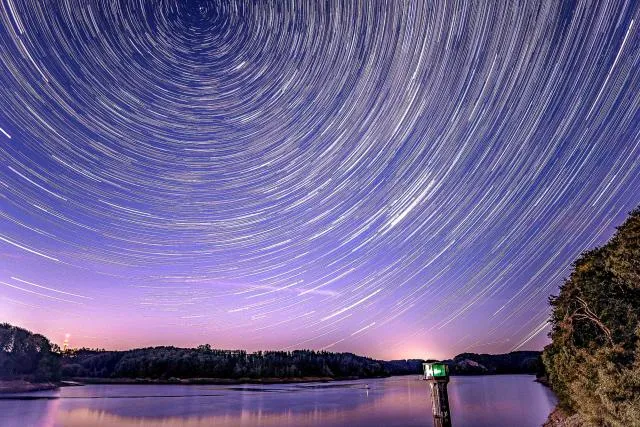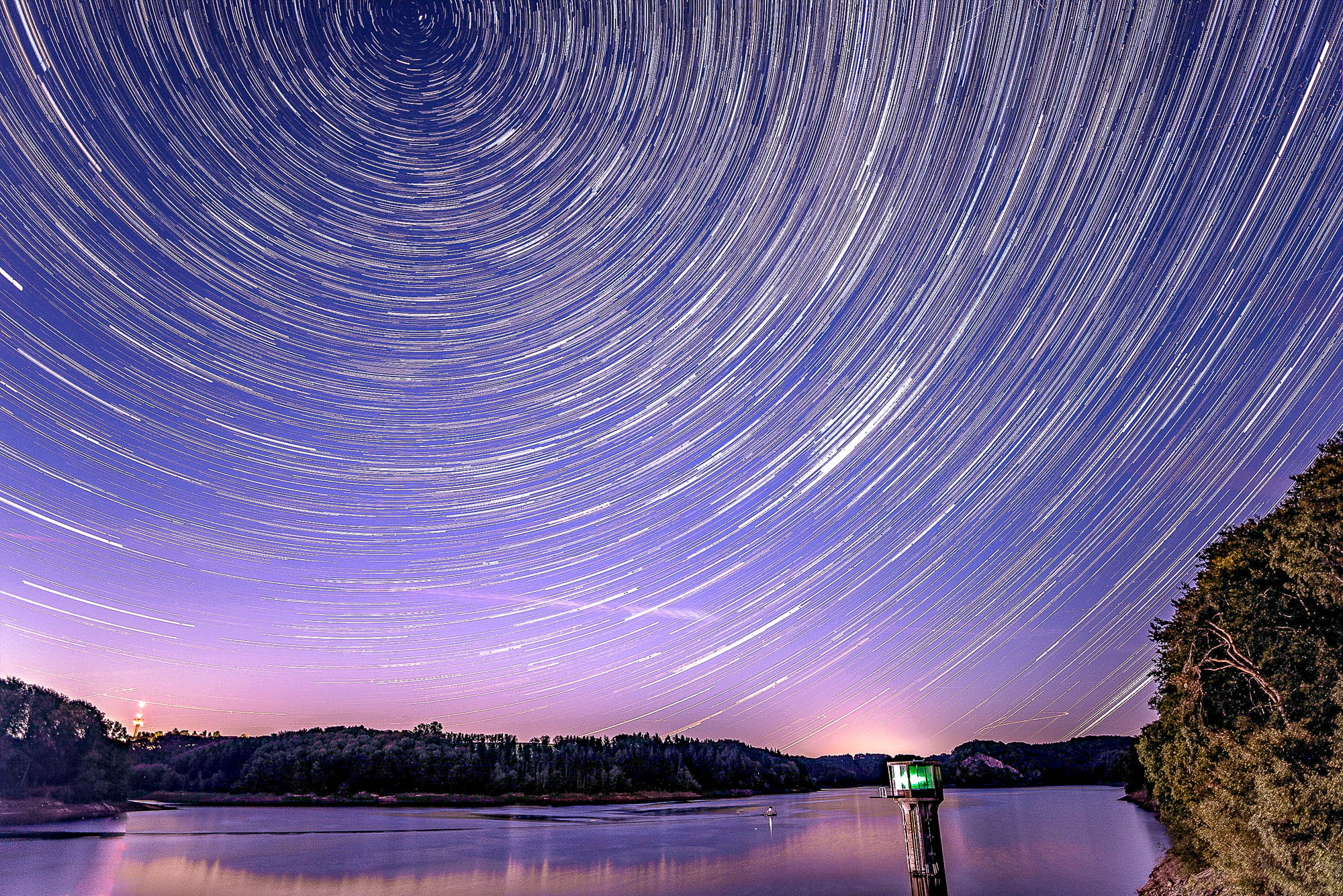For several years we have been dealing with the recording of star trails or star tracks, i.e. the supposed movement of the stars on concentric circular orbits around the polar star. If there were no technical restrictions with commercially available cameras, one could capture this star movement with a long exposure of several hours and would get a picture that showed segments of these circles with the polar star in the center. In practice, unfortunately, this does not work - camera / sensor errors, clouds, airplanes, etc. with this procedure would ensure that a completely overexposed picture appears as the result after a few hours of exposure.
Therefore, the procedure for star trail photography is completely different. Many individual recordings are made here in series, which will later be put together in a suitable program. The following article describes the entire process from the prerequisites to the developed star trail image.
Where and when can star trails be photographed?
To be able to record star trails, you have to be able to see stars - this seemingly trivial condition is almost the greatest challenge for successful star trail projects, because their implementation is difficult in many places. First of all, the light pollution at the location of exposure must be low. To check whether the location that you are considering for night shots fulfills this condition, it is worth checking it first using the light pollution map. This already shows that e.g. urban areas are completely unsuitable. In Germany, on the other hand, the Eifel is an area that is well suited for astronomical night shots due to the low light pollution. The moon phases also play a role in star trail photography. Ideal shooting conditions can only be found shortly before or after the new moon, i.e. when the crescent moon emits some light to illuminate a possibly selected subject in the foreground of the shooting scene. The full moon, on the other hand, is far too bright and outshines the rather faint stars.
An entire moon phase cycle from one new moon to the next new moon (lunation) lasts on average about 29.5 days, which means that there is only 12 times a chance, in a period of maybe three days around the new moon, a suitable night for starting trail recordings to find. As if this was not already difficult enough to accomplish, the sky must be clear and starry at night, it must not be raining or foggy, etc. These environmental conditions make star trail projects a very complex and difficult undertaking - but also the necessary technology - recording and development - is not without, if you want to create impressive star trail pictures that can captivate the viewer without obvious retouching.
What should be photographed?
Once the optimal location for the camera position has been found, it must be checked whether a stable tripod can be set up there for a period of at least 3 hours in an extremely stable and motionless manner. This places demands on the subsoil (swamp areas are excluded ;-)) but also on the susceptibility to wind etc.
Next up is the season. The least annoying haze is on cold nights, but then the lens used is cold and if you e.g. has placed the camera near wetlands, the lens may fog up. The recordings created in this way would then be unusable. A countermeasure would be to temper the lens. There are electrically operated lens warmers e.g. by Coowoo (with whom I have not yet had any experience). In general, it is advisable to bring the camera-lens combination up to the operating temperature before the actual recording cycle is started in order to avoid possible thermal effects due to a rapid change in temperature from room to outside temperature of the combination. For this purpose, the camera and lens are brought into the open some time before the series of shots.
How to take photos of star trails?
The sample photos in this entry were taken with the cameras: Nikon D810 or Nikon D850 in combination with the Nikkor 20mm f / 1.8 lens. The full-frame sensor of the two cameras has a favorable effect on the noise, the f / 1.8 relatively large open aperture ensures good light output.
Before you start, you have to decide how you want to take the series of more than 200 pictures. On the one hand, there are remote triggers where you can directly set the intervals and recording time, as well as the number of shots. With the Nikons, however, this can also be set directly in the camera, so that they are e.g. 300 shots with e.g. shoots for 30 seconds each. I operated the Nikon D850 in the so-called live view mode, in which the camera held up the mirror between the individual shots. This prevents vibrations and protects the mechanical lock. Especially on cold nights, the use of a handle with an additional battery is recommended, since changing the battery during the series of recordings is of course less than ideal.
The correct distance setting is the first hurdle. To focus on infinity (stars), the depth of field for aperture 16 is displayed on the lens, which unfortunately is of little use, since you can take star trail pictures with an open aperture (here f / 1.8). If I want to sharply depict my selected subject as well as the starry sky (∞), I need the range e.g. from 10 m (subject) to ∞, which is to be shown sharply. Here you can (must) take test shots until you have found the correct focus, but you can also use the Photopills program, which for many camera / lens / aperture combinations directly specifies the focus range, from which you can then take your tests can go out.
Incidentally, now is a good time to fix the setting ring for distance adjustment on the lens, e.g. with an adhesive tape. For night shots, you don't necessarily have the routines that help you take daylight shots, and so some photo series have had an unfortunate end at night, because when you touch in the dark you got to the darn setting ring for the distance setting, which will later appear on the monitor led to pretty spots of light instead of the sharply shining stars.
At the latest now all automatic functions must be switched off (autofocus, stabilizer (camera / lens, ISO automatic). If available, the long exposure mode of the camera must also be switched off, which creates a dark frame (see below) with the identical recording settings after a recording - So another 30s recording with the shutter closed for each recording!
Which aperture, which exposure time?
The aperture is open, now you have to find the optimal setting for the parameters ISO and exposure time, which remain constant for the entire series. In the various tutorials on the Internet, ideal combinations are sometimes given, but they only make sense if the above. Requirements match the suggested values: So, same camera, lens, season, location etc.? In the example shots I specified the settings made there for orientation, because in such a complex project the optimal combination depends on the ratio ISO / noise of the camera, the value of the open aperture of the lens etc. and should be determined on site using test shots.
The recordings are in the box - and now?
There are now some 100 pictures, so-called light frames, on which up to 30 seconds of star movements have been recorded. These recordings must now be combined to form an overall picture, which is also called stacking. Before doing this, you have to check the images for quality and, if necessary, sort out those on which planes, satellites, shooting stars, clouds have left unwanted traces. Here you have to consider that many recordings of a partial series that you sort out lead to corresponding gaps in the start trail recording that you create in the next step.
A start trail recording can now e.g. can be created with Adobe Photoshop by first importing all light frames into Photoshop directly as layers (works easily from Adobe Lightroom). These are then placed one on top of the other so that the small arcs of the individual images in the resulting overall picture merge seamlessly into the planned larger circle segment. If you have previously separately and precisely photographed the selected subject with better lighting or with Lightning methods, you can now insert it directly into the Photoshop result and you can see the first draft of its combination of motif / star trail in Photoshop for possible further processing steps.
If you don't have Photoshop or if you prefer software optimized for creating star trails, you can find various freeware offers on the Internet.
The fastest results can be achieved with the programs Starstax by Markus Enzweiler and Startrails by Achim Schaller. There are suitable tutorials to help you get started. However, it should at least be pointed out to the advantage of these special software solutions that these programs can also independently fill the gaps within the star trails that result from the sorting out of disturbed recordings (aircraft, car headlights, etc.). In addition, the special solutions improve the result by being able to take into account so-called dark frames, flat frames and offset / bias frames (DeepSkyStacker) in addition to the light frames in order to reduce camera / optics and sensor errors. The program that can also handle raw files is DeepSkyStacker. Although this is somewhat more complex to configure and familiarize with, it is generally worthwhile with regard to other astronomical photo projects (Milky Way, Deep Sky etc.). These programs are in top form, if you not only feed them with light frames, but at least with dark frames.
How do you create light frames, dark frames, flat frames and offset / bias frames?
Light frames are the actual shots. They contain the motif information, i.e. stars in combination with the motif object. They are created as previously described.
Dark frames are pictures taken with the lens cap closed. Although they do not contain any motif information, they do indicate the electrical and thermal condition of the image sensor. These pictures should be completely black, which, however, e.g. Prevent effects such as dark current and hot pixels. They arise from thermal and electrical influences within the camera and cause the sensor to record weak signals even when there is no light information. Although this does not contain any light information, it does provide information about interference that affects the camera sensor. This current is different for each pixel and increases with the temperature of the sensor. The pixels that have an above-average dark current are called hot pixels. The stacking software subtracts the darkframes from the lightframes in order to minimize these effects. To do this, dark frames must be recorded with the same camera settings (ISO, exposure time) and under the same environmental conditions (temperature) as the light frames. In order to minimize statistical effects, the dark frames are also averaged by the software and a correspondingly high number of dark frame shots is therefore required. Even if as above the camera and the lens should start at the right temperature, sometimes this does not work completely. Thus, the dark frames are better recorded after the completion of the light frame series. The theory requires the same number of dark frames as light frames to produce, which in practice, however, took a long time. Assuming 300 light frames a 30s corresponding to 9,000 seconds or 2.5 hours, a further 2.5 hours would be necessary to create the dark frames. For my star trail projects, I created 50 dark frames at the end of each series using the same settings as for the light frames with the lens cover closed.
Flat frames correct aberrations in the lenses used, such as vignetting and image errors due to sensor contamination. On the one hand, all optics produce image errors and, on the other hand, not all pixels in the sensor react equally to incident light. Rather, the percentage of photons that release an electron varies both with the wavelength (quantum efficiency, optimal (and unreachable) one electron arrives at a received photon) and from pixel to pixel. Flat frames are recorded to compensate for these possible inhomogeneities in the image illumination (vignetting) and contamination of the sensor. The camera structure as well as all settings and environmental conditions should match the planned start trail series and should be set manually. The exception is the exposure setting, which should be set to AV automatic. In this setting, around 30 flat frames are now recorded, in which a white cardboard is held in front of the camera or you use the t-shirt mode occasionally described in the literature (you throw a white t-shirt over the camera) and then about the necessary 30 shots.
Offset / BiasFrames correct deviations of the A / D converter of the camera. For each pixel, the bias frames are to record all deviations from the signal accumulated during the exposure, which are systematically caused by the measurement process on the A / D converter. In addition, during the short readout time of the sensor there are signal increases due to the dark current (see above), the statistical fluctuation of which also overlaps the characteristic deviation for each pixel. In order to minimize these random deviations from the ideal bias frame sought, around 50 bias frames should be recorded and (median - not arithmetic!) Averaged. For this purpose, a picture is recorded with the shortest possible exposure time with the shutter closed, so that no light hits the recording chip. If this cannot be achieved with the camera, a lens cap can also be used. The image that is then read out only contains the numerical values that are still produced by the reading process itself and that are characteristic of each individual pixel.
Another short checklist for the start of the recording series:
Eyepiece shutter closed?
All automatic functions (ISO, long exposure, vibration / shake, autofocus ...) switched off?
Tripod is stable and is weighted down if necessary?
Is the distance ring on the lens fixed (adhesive tape)?
Batteries are full and in the battery grip?
Have you taken test shots for exposure and focusing?
Exposure is set to M and time (e.g. 30s) and aperture (e.g. 1.8) and ISO (e.g. 800) is set?
Flat frames and bias frames created?
Red light head lamp is ready for use?
Don't forget dark frames!
Coffee available?
Good luck then!




